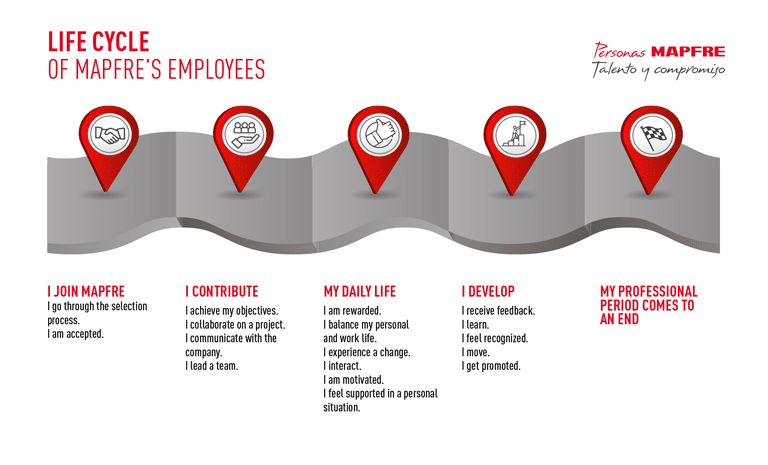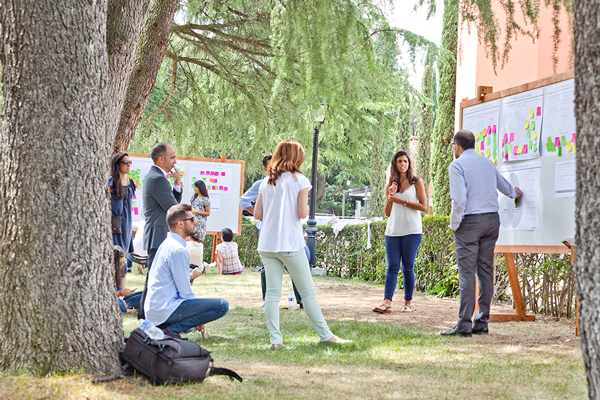We introduce and explain our Model for Listening and Measuring Employee Experience
I can only give you the best experience if I listen to you. As a result, now that we can fully understand and monitor your experience, we can make decisions that positively impact your daily life. This model has already become a new human resources tool and involves three stages.
1. It measures your recommendation, satisfaction and commitment index, using a questionnaire, the Relational eNPS®
which is taken in May and November and measures the likelihood that you would recommend MAPFRE as a company to work for. In 2020, it was applied in 13 countries to the total workforce; 98 percent are in countries with an Employee Net Promoter Score above 20 points.
We also measure the Leader Index, which measures the degree to which employees would recommend their managers on a recommendation scale of 0 to 10. In 2020, 61 percent of employees gave a score of 9 or 10.
The Employee Satisfaction Index. What are the main elements that impact employee engagement?
- Knowledge of the objectives
- Pride in the work done
- Recognition for work performed
- Contribution to the company
- Quality feedback received
- Opportunities for development
- Collaboration
- Work tools
- Looking after people
- Pride in the social footprint.

2. Employee life cycle
The employee experience is a journey and the employee life cycle identifies the main moments in a person’s life within the company, those in which a good or bad experience has a special significance for that employee. These are called “Moments of Truth”.
At MAPFRE we have designed our own employee life cycle, which consists of 18 moments. How do we measure this cycle?
- Through focus groups, which at MAPFRE we call experience pulses, involving groups of employees who make up a representative sample of the workforce or groups of employees who represent a sample of specific groups (young people, senior profiles, strategic profiles, expatriates, new hires, recent promotions, etc.), who may have a different experience at certain points in their life cycle than that of the employees as a whole.
- The Transactional eNPS® questionnaire, which consists of short questionnaires that are triggered when the employee interacts with one of the moments in the life cycle (training, mobility, evaluation, etc.).
3. The Human Resources Management Perceived Quality Index
This evaluates the quality of the service provided by the human resources areas and the ability to evolve and adapt the people management to the needs of the company and its employees. It is obtained through an assessment questionnaire that is sent out to all employees around the world once a year. In 2020, the score was 7.9 out of 10.
This questionnaire measures four variables: the service provided, response times to any consultation or service requested, the quality of the service, and the evolution and adaptation of people management to meet the needs of the company and its employees.
A model developed by MAPFRE
Our Model for Listening and Measuring Employee Experience is proprietary, entirely developed and built in-house at MAPFRE.
In this process, and specifically during the preparation of the Relational eNPS®, the support and advice of the Corporate Business Support Area was very important, particularly the Quality Observatory, which is responsible for understanding how customers perceive the company, both in terms of an overall assessment of the organization and the so-called critical episodes of interaction with a customer (Contracting, Renewal, Incident Management, Claims, Assistance, etc.).
The Quality Observatory, independently of Human Resources, is responsible for implementing, measuring and reporting the results of the Relational eNPS® for employees. This is conducted twice a year and measures the likelihood that you would recommend MAPFRE as a company to work for.
«La colaboración con el equipo de Experiencia Empleado ha sido muy estrecha. El Observatorio de Calidad realiza, de manera independiente las encuestas y los análisis previos de los resultados obtenidos. Creo que la realización de estas encuestas, así como de los análisis correspondientes por parte de un equipo totalmente independiente da una garantía de imparcialidad, que considero junto con el anonimato de las encuestas, crítico para que los empleados MAPFRE se sientan cómodos contestando las preguntas y podamos considerar a las mismas con un grado de certidumbre muy elevado. Por otro lado, la magnífica participación que están teniendo las distintas oleadas que se realizan, nos da una idea de lo atractivo que para el empleado es dar su opinión y comprobar cómo las distintas áreas de RRHH de las compañías se mueven en base a los resultados de las diferentes oleadas.” José Manuel Martínez Iglesias, máximo responsable del Observatorio de Calidad de MAPFRE en el Área Corporativa de Operaciones (Área Corporativa de Soporte de Negocio)”.
“There has been a very close collaboration with the Employee Experience team. The Quality Observatory independently conducts surveys and makes preliminary analyses of the results obtained. I believe that doing these surveys, combined with the corresponding analyses by a totally independent team, provides a guarantee of impartiality. Together with the anonymity of the surveys, I feel this is critical so that MAPFRE employees feel comfortable answering the questions and we can regard them as being very reliable. On the other hand, the magnificent participation in the various campaigns that are being conducted gives us an idea of how attractive it is for employees to be able to have their say and see how the different HR areas in the companies respond to the results of these different survey rounds.” José Manuel Martínez Iglesias, head of MAPFRE’s Quality Observatory in the Corporate Operations Area (Corporate Business Support Area)”.
The Transactional eNPS® was developed jointly by the HR teams of the different countries
Measuring the employee experience means gauging what they experience —what happens to them at any given moment and which are concrete facts— and what they feel —subjective perceptions— and linking this to satisfaction, recommendation (the eNPS), engagement and so on.
It helps us to identify what is key for you and to know which levers we need to operate to improve your experience, engagement and development, and even link this to the customer experience.
Our model, which is already fully implemented in several countries, and partially in many others, always strives to put the employee at the core.






